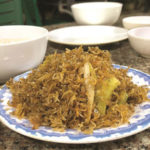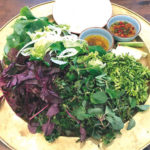Com Vong or Green sticky rice in Vong Village together with 10 dishes and specialties from Vietnam have recently been added to the Asian Culinary Records.
Ten newly recognized culinary records
| Egg coffee and green sticky rice are among Hanoi’s delicacies. Photo: Tuan Nguyen |
The newly recognized records encompass the Saigon bread from Ho Chi Minh City, mussel rice from Thua Thien-Hue Province, Phan Thiet hotpot from Binh Thuan Province; vermicelli soup with special broth from Soc Trang Province; Ninh Hoa grilled fermented pork roll from Khanh Hoa Province; sesame candy from Thua Thien-Hue; Da Lat strawberries from Lam Dong Province; dried sweet potatoes from Quang Binh; Tra Cuon cylindrical sticky rice cake from Tra Vinh Province; and particularly, the green sticky rice or Com Vong from Vong Village in Hanoi.
So far, 60 Vietnamese dishes have been acknowledged in Asian Culinary Records to “bring the essence of Vietnamese cuisine to the world.”
According to a representative of the Vietnam Records Organization (VietKings), Vietnamese cuisine and specialties in each of the 63 cities and provinces have unique flavors, ingredients, and ways of using and combining spices.
What sets Com Vong apart?
| Young glutinous rice, the raw material for Com Vong. Photo: Duy Khanh/The Hanoi Times |
Visitors arriving in Hanoi in the fall and winter will come across vendors selling green rice flakes on the streets. As simple as the country snack, com or young sticky rice, is an unmistakable Hanoi specialty.
It is difficult to determine when the craft emerged, but the Hanoi specialty has been well-known locally and internationally for centuries.
Com Vong, or green sticky rice, was created by residents in Vong Village, or present-day Dich Vong Hau Ward, Cau Giay District in Hanoi. The glutinous rice suitable for this specialty must be nearly ripe, still containing the rice milk and fragrance. To produce delicious and aromatic young rice, the raw material must be carefully selected. The glutinous rice must be Nep cai hoa vang or special round-grain glutinous rice.
| A Com Vong vendor in Hanoi. Photo: Nguyen Tuan |
Vong villagers claim that making Com Vong is a meticulous process. First, high-quality rice is selected, then threshed, sifted, and washed in large washers to eliminate the thin grains that float to the surface. The rice is then dried in a large iron pan over a wood fire. Next, it is pounded by machines. For every ten kilograms of sticky rice, only about two kilograms of young rice is produced.
The pounding and drying process for com is the most crucial step. These techniques are often kept within the household, never shared with outsiders or daughters for fear that they might pass it on to their husband’s family.
Despite numerous challenges throughout history, the long-standing craft of producing Com Vong is still well-preserved and thriving. Nguyen Thi Thao, a Com Vong producer from Dich Vong Hau Ward, Cau Giay District, Hanoi, mentioned that she is the 5th generation in her family to practice this profession.
| Com Vong, a popular delicacy of Hanoi. Photo: Duy Khanh/The Hanoi Times |
“My family’s com-making trade has a long history. My great-grandparents handed it down to my grandparents, who passed it on to my parents, and now I’ve been involved in the traditional trade for more than 40 years,” she stated.
The process of urbanization and modernization within the city has transformed the rural village of Vong into a cosmopolitan area. The rice fields are gradually being replaced by tall office buildings, bustling residential complexes, and vibrant commercial zones. Nevertheless, the people here remain passionate about preserving their ancestors’ traditional craft. With no fields left for paddy cultivation, they must purchase young rice from other places to create this specialty.
In addition to Vong Village in Cau Giay District, Com is also produced in Me Tri Village, or the present Me Tri Ward, Nam Tu Liem District, Hanoi. However, the young rice produced in Vong Village is said to be the most fragrant and delicious.
| Xoi Com or sweetened green sticky rice. Photo: Quynh Duong |













